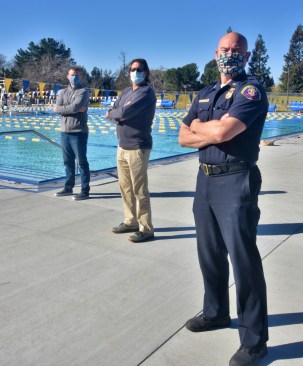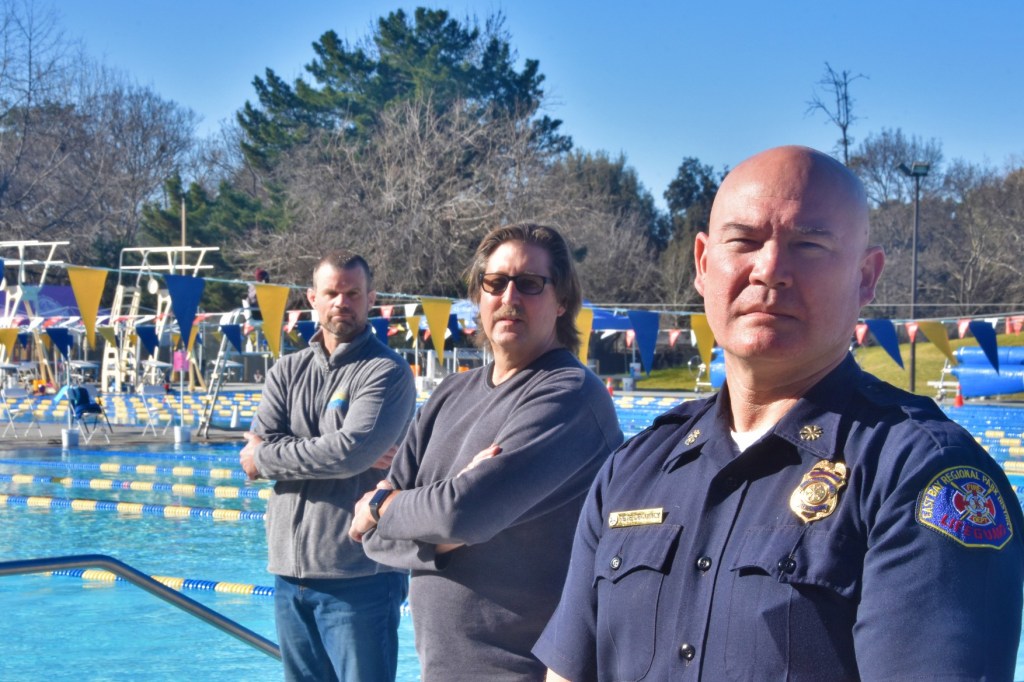Even under normal circumstances, it’s difficult to get standards and codes that apply to most situations. When you add a situation like the COVID-19 pandemic — unprecedented in our lifetimes, so no operators’ manual exists; yet requiring a quick response — it seemed basically impossible.
“In the early days of the pandemic, there was this paralysis of, ‘How do we proceed?’” says Pete DeQuincy, aquatic manager, fire department and lifeguard service for East Bay Regional Park District in Castro Valley, Calif. “There were a lot of unknowns.”
So the California Parks and Recreation Society’s Aquatics Section decided to take matters into its own hands.
Seeking standardization

Eric Nurse/East Bay Regional Park District
George Deines making a presentation
When the stay-at-home orders were first instituted, CPRS members began to get glimpses of regulations under consideration by local agencies. But some proposals didn’t align with existing code or established best practices, and some wouldn’t apply to all aquatics centers. For instance, one of the facilities managed by the City of Concord is more than 50 years old.
“So bathrooms tended to be challenging,” says Matthew Galindo, recreation program coordinator with City of Concord Parks and Recreation. “Some of the newer facilities had individual stalls, but I just had group showers. So the one-size-fits-all shower method wasn’t going to work.”
Pre-existing code states that showers must be available anytime the facilities are open. However, a group shower doesn’t necessarily promote COVID-safe practices. “If they can’t maintain social distancing, then I can’t use my showers,” Galindo says. “Does that mean I can’t open anymore?”
And officials hadn’t figured out yet how lifeguards could provide basic life support without creating an aerosol-generating event.
The CPRS Aquatics Section didn’t want to wait for officials to decide so it asked three members — Galindo, Peter Beireis and Pete DeQuincy — to work on guidelines for operating aquatics facilities during the pandemic. The group intended to create a document that could be adopted in part or full by all of California’s 58 counties.
“We took a proactive approach,” Galindo says. “Instead of waiting to have things dictated to us, we would try to provide information and guidance on how we did things.”
To help the process move quickly, the team divided the work — DeQuincy handled protocol for lifeguarding and swim lessons; Beireis managed additional programming such as lap swimming and aquatic aerobics, while Galindo addressed how to open the physical facilities.
In addition to the short timeline, they needed to make sure the language would keep everybody safe and wouldn’t result in any unforeseen consequences.
They figured they’d take an approach used by Emergency Medical Services around the country. “Anything an EMT or paramedic does in the field has the oversight of a … medical doctor backed by a panel of other medical professionals,” Galindo says. “Every decision they make for in-field guidelines is based off research and information from far greater educated people.”
For the same kind of credentials, the team met with a representative from the Centers for Disease Control and Prevention to learn the latest information and recommendations. “We picked his brain and based the fundamentals of how to open pools, provide programming, and provide lifeguarding based on his recommendations,” DeQuincy says.
They also hunted down all the relevant materials they could find from experts such as the World Health Organization.
Far-reaching efforts
Meeting nearly every day to report on their progress, the trio finished the 58-page protocol in about three weeks.
Officials proved receptive. Almost immediately, it was picked up in the San Francisco Bay counties where they work. In short order, most counties in the state picked up at least part of the document.
“The fact that we did the work for them, I think, really made the difference,” DeQuincy says.
This helped place aquatics on the path to reopening in California. “Even when we had agencies that were closing playgrounds … we were able to do something that would enable aquatics centers to operate again,” Galindo says.
Facility users have also expressed their appreciation. “We have received an overwhelmingly positive response about … how grateful they are that we could return at least some level of normalcy back to their lives,” Galindo says.
The impact stretched past California borders, with several other states and municipalities adopting part or all of the language. DeQuincy presented it to professionals in Texas, Kansas, Utah, Wisconsin, Colorado and Washington. Questions and requests still come from across the country, says Beireis, senior recreation supervisor for the City of Newark.
“I’ve talked to a number of pool operators who say, ‘Thanks. We submitted this to our Health Department and they’ve [adopted] it.’”
